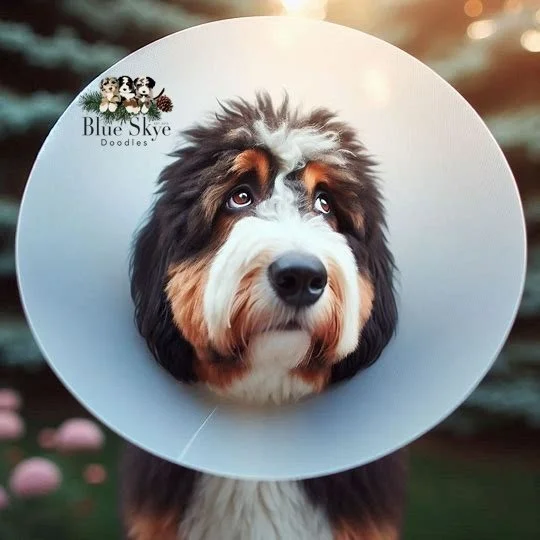
When to Spay or Neuter Your Doodle Puppy
Spay/Neuter Recommendations for Bernedoodles and Australian Mtn. Doodles?
Updated as of May of 2024:
The World Small Animal Veterinary Association (WSAVA) has just announced their new spay and neuter guidelines. Due to growing evidence of adverse health effects of traditional gonadectomy (spay/neuter) and increases in cancers and joint disorders, WSAVA suggest the best practice for RESPONSIBLE pet parents is to leave dogs and cats unaltered (intact).
Additionally noting, spaying or neutering a dog younger than 6 months of age is NOT recommended because of an increase of detrimental health risks. Acknowledging in some circumstances, such as rescues and shelters, where leaving an animal intact is not an option, they stress the importance of education and acceptance of newer, alternative sterilization techniques that have less long-term health concerns.
We have long been told that responsible pet ownership means spaying or neutering your dog. In the United States, it has been common to have all dogs and cats not meant for breeding purposes spayed (ovariohysterectomy for females) or neutered (castration for males). In fact, 78% of dog-owning households have spayed or neutered their canine companions according to the American Pet Products Association’s 2019-2020 National Pet Owners survey.
This near-routine practice was a result of veterinarians and the animal shelter community working together to reduce the number of unwanted animals that would be euthanized.
The relationship between sex hormones and canine health was not well-considered and understood decades ago when the early spay/neuter campaigns were started. Today, we are discovering that possibly some of those decisions may have affected the health of some dogs.
Research conducted by the University of California – Davis reveals that for some dog breeds, neutering and spaying may be associated with the increased risks of certain health conditions such as joint disorders including hip or elbow dysplasia, cranial cruciate rupture or tear, and some cancers, such as lymphoma, mast cell tumor, hemangiosarcoma, and osteosarcoma. Additional scientific evidence indicates shortened lifespans, atypical cushing’s disease, cardiac tumors, bone cancer, urinary incontinence (in females) and urethral sphincter incontinence (in males) is also more common in our neutered/spayed pets. The research conclusions are not surprising. Sex hormones are important in the development of any animal. We know they affect psychological development as well as the musculoskeletal, cardiovascular, and the immune system.
There are two medical conditions that actually can be totally eliminated by desexing, Benign prostatic hypertrophy or BPH (enlarged prostate) and Pyometra (a disease of the uterus). However there is a wealth of information indicating that preserving innate sex hormones, especially in the first years of life has more benefits to pets, whereas the risk of pyometra or BPH in an animal’s first year of life is incredibly low. Compare these two lists of possible adverse conditions vs. benefits and decide for yourself.
Recommendation: DO NOT spay/neuter before 9 months of age, and wait until 12+ months of age for males.
Females usually have their first heat cycle between 6 to 12 months of age, often at roughly 8 or 9 months. Their 2nd heat cycle will usually begin roughly 6 to 8 months after that. Scheduling your spay surgery for a few months after their cycle has started allows you to be sure you aren’t inadvertently spaying during their heat cycle as that could exacerbate excessive bleeding.
Please consider non-surgical sterilization options that render dogs sterile and unable to reproduce instead of traditional desexing methods (spay/neuter). Ovary Sparing Spay (or hysterectomy) for females removes the uterus (preventing pyometra) but leaving ovaries and hormones intact while still preventing pregnancy.
To find out more and locate a practicing Veterinarian in your area, click the link below.
2024 Updated Guidelines & Links:
-

UC Davis May 28, 2024 Update
Researchers at UC Davis looked at the correlation between neutering or spaying a dog before 1 year of age and a dog’s risk of developing certain cancers. These include cancers of the lymph nodes, bones, blood vessels or mast cell tumors for some breeds; and joint disorders such as hip or elbow dysplasia, or cranial cruciate ligament tears. Joint disorders and cancers are of particular interest because neutering removes male and female sex hormones that play key roles in important body processes such as closure of bone growth plates.
-

Guidelines by Breed & Sex
The recent paper in Frontiers in Veterinary Science has added five breeds to a line of research that began in 2013 with a study suggesting that early neutering of golden retrievers puts them at increased risk of joint diseases and certain cancers. The study lays out guidelines for pet owners and veterinarians for specific breeds and gende sto assist in making a neutering decision.
-

Sterilization Instead of Spay/Neuter
The term “desexed” refers to the traditional surgical technique of removing all sex hormone secreting tissues in a pet’s body (spaying and neutering). This is different from “sterilization” which refers to surgically rendering an animal incapable of reproducing, but still capable of producing sex hormones. Dr. Karen Becker (co-author of The Forever Dog) discussed alternatives.
